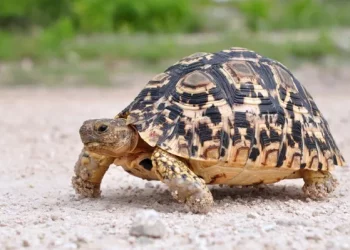Horsefield tortoises, also known as Russian tortoises, are popular pets known for their hardy nature and relatively easy care requirements. One crucial aspect of their care is bathing. Regular baths help maintain their health, hydration, and overall well-being. This article will delve into the optimal frequency and methods for bathing your Horsefield tortoise, ensuring it thrives in captivity.
Why Bathing is Essential
Bathing your Horsefield tortoise serves several important purposes:
Hydration: Tortoises can absorb water through their skin and cloaca (the common cavity into which the intestinal, urinary, and reproductive tracts open). Regular baths ensure they stay hydrated, which is vital for their health.
Cleanliness: Bathing helps remove dirt, debris, and potential parasites from the tortoise’s shell and skin. This is particularly important as tortoises can accumulate dirt from their environment.
Shedding Assistance: Tortoises periodically shed their skin, and soaking helps loosen and remove old skin, preventing complications.
Stimulation of Defecation: Bathing often stimulates bowel movements, helping maintain regular digestive health.
Optimal Bathing Frequency
Determining the appropriate bathing frequency for your Horsefield tortoise depends on several factors, including age, health, and environmental conditions. Here are general guidelines:
Hatchlings and Juveniles: Young tortoises require more frequent baths as they are more susceptible to dehydration. Bathing them 2-3 times a week is recommended. Ensure the water is shallow and lukewarm.
Adults: Adult Horsefield tortoises typically need baths once a week. However, if the environment is particularly dry, or if your tortoise seems dehydrated, you may need to increase the frequency to twice a week.
Elderly or Sick Tortoises: Older or ill tortoises might require more frequent baths to ensure they remain hydrated and clean. Consult with a veterinarian for specific recommendations based on your tortoise’s condition.
Bathing Technique
Proper bathing technique is crucial for the safety and comfort of your Horsefield tortoise. Follow these steps:
Water Temperature and Depth: Use lukewarm water, around 85-90°F (29-32°C). The water should be shallow, no higher than the tortoise’s chin, to prevent drowning.
Bathing Container: Use a clean, shallow container or a designated tortoise bath. Avoid using sinks or bathtubs used for human hygiene to prevent cross-contamination.
Bathing Duration: Allow your tortoise to soak for 15-20 minutes. This is usually sufficient for hydration and cleaning. Always supervise your tortoise during baths to ensure its safety.
Drying: After bathing, gently pat your tortoise dry with a soft towel. Ensure it is completely dry before returning it to its enclosure to prevent shell rot and other health issues.
Signs Your Tortoise Needs a Bath
While following a regular bathing schedule is essential, there are signs indicating your tortoise may need an extra bath:
Dry Skin or Shell: If your tortoise’s skin or shell appears dry or flaky, an additional bath can help rehydrate and assist with shedding.
Dirt or Debris: Visible dirt or debris on your tortoise’s shell or skin should prompt an extra bath to maintain cleanliness and prevent potential infections.
Dehydration Signs: Symptoms like sunken eyes, lethargy, or a lack of appetite can indicate dehydration. Increasing the frequency of baths can help rehydrate your tortoise.
Environmental Considerations
The environment in which your Horsefield tortoise lives plays a significant role in determining bathing frequency. Consider the following factors:
Humidity Levels: Horsefield tortoises originate from arid regions and thrive in relatively dry conditions. However, captive environments often differ. Monitoring and maintaining appropriate humidity levels in their enclosure can reduce the need for frequent baths.
See Also: How to Keep My Tortoise Warm at Night?
Substrate Type: The type of substrate used in the enclosure can affect your tortoise’s cleanliness. Loose substrates like soil or sand can stick to the tortoise, necessitating more frequent baths.
Diet and Hydration: A balanced diet rich in fresh vegetables and proper hydration through water bowls can help maintain your tortoise’s hydration levels, potentially reducing the need for frequent baths.
Health Benefits of Regular Bathing
Regular bathing offers numerous health benefits beyond basic cleanliness and hydration:
Prevention of Respiratory Issues: Proper hydration helps prevent respiratory infections, which are common in dehydrated tortoises.
Enhanced Digestion: Soaking can stimulate bowel movements, aiding in regular digestion and preventing constipation.
Parasite Control: Bathing helps remove external parasites like mites and ticks, reducing the risk of infestations.
Stress Reduction: Regular, gentle baths can be a relaxing experience for your tortoise, reducing stress and promoting overall well-being.
Common Bathing Mistakes to Avoid
While bathing your Horsefield tortoise is generally straightforward, avoid these common mistakes to ensure your tortoise’s safety and health:
Using Hot or Cold Water: Extreme water temperatures can harm your tortoise. Always use lukewarm water within the recommended temperature range.
Overbathing: Bathing too frequently can strip natural oils from your tortoise’s skin and shell, leading to dryness and other issues. Stick to the recommended schedule unless advised otherwise by a veterinarian.
Deep Water: Never use deep water for bathing, as tortoises can drown easily. Keep the water shallow and ensure your tortoise can comfortably keep its head above water.
Ignoring Hygiene: Ensure the bathing container is clean and free from contaminants. Using a dirty container can introduce harmful bacteria to your tortoise.
Consulting a Veterinarian
If you’re unsure about the appropriate bathing frequency for your Horsefield tortoise, or if you notice any unusual behavior or health issues, consulting a reptile veterinarian is crucial. A vet can provide tailored advice based on your tortoise’s specific needs and health status.
Conclusion
Bathing your Horsefield tortoise is an essential aspect of its care routine, contributing to its hydration, cleanliness, and overall health. By understanding the optimal bathing frequency and following proper techniques, you can ensure your tortoise thrives in captivity. Regular baths, combined with a well-maintained environment and a balanced diet, will help keep your Horsefield tortoise healthy and happy for years to come.
Related Topics:

























